MCFI-Net: Multi-Scale Cross-Layer Feature Interaction Network for Landslide Segmentation in Remote Sensing Imagery
Abstract
1. Introduction
- (1)
- By constructing a structure with tightly connected layers through cross-layer feature interaction, we can more effectively integrate hierarchical information. This design promotes the dissemination of low-level spatial details and high-level semantic representations, enhancing the model’s ability to understand the complex structure of scenes.
- (2)
- The receptive field block is embedded into the skip connection path to enhance the preservation and transfer of spatially informative features from the encoder to the decoder. This module enriches the context flow in different network stages and makes the depiction of the target area clearer.
- (3)
- The multi-branch dynamic convolution block is introduced, equipped with dynamic perception capabilities and powerful multi-scale feature extraction. This adaptive module is designed to selectively respond to varying spatial patterns and object scales by dynamically adjusting convolutional kernels.
2. Materials and Methods
2.1. Overall Architecture of MCFI-Net
2.2. Encoder Block
2.3. Decoder Block
2.4. Receptive Field Block
3. Results
3.1. Dataset
3.2. Model Configuration and Evaluation Metrics
3.3. Ablation Experiment
3.4. Results for Landslide4Sense Dataset
3.5. Results for Bijie Dataset
3.6. Results for EORSSD Dataset
3.7. Complexity Analysis
3.8. Selection of the Optimizer
3.9. Selection of the Loss Function
4. Conclusions
Author Contributions
Funding
Data Availability Statement
Conflicts of Interest
References
- Yang, Y.; Miao, Z.; Li, X.; Zhang, H.; Chen, S. LSL-SS-Net: Level set loss-guided semantic segmentation networks for landslide extraction. GISci. Remote Sens. 2024, 61, 2416727. [Google Scholar] [CrossRef]
- Han, Z.; Fu, B.; Fang, Z.; Li, Y.; Li, J.; Jiang, N.; Chen, G. Dynahead-YOLO-Otsu: An efficient DCNN-based landslide semantic segmentation method using remote sensing images. Geomat. Nat. Hazards Risk 2024, 15, 2398103. [Google Scholar] [CrossRef]
- Lv, J.; Zhang, R.; Wu, R.; Bao, X.; Liu, G. Landslide detection based on pixel-level contrastive learning for semi-supervised semantic segmentation in wide areas. Landslides 2025, 22, 1087–1105. [Google Scholar] [CrossRef]
- Kaushal, A.; Gupta, A.K.; Sehgal, V.K. A semantic segmentation framework with UNet-pyramid for landslide prediction using remote sensing data. Sci. Rep. 2024, 14, 30071. [Google Scholar] [CrossRef]
- Zhu, X.; Zhang, Z.; He, Y.; Wang, W.; Yang, S.; Hou, Y. LandslideNet: A landslide semantic segmentation network based on single-temporal optical remote sensing images. Adv. Space Res. 2024, 74, 4616–4638. [Google Scholar] [CrossRef]
- Liu, B.; Wang, W.; Wu, Y.; Gao, X. Attention Swin Transformer UNet for Landslide Segmentation in Remotely Sensed Images. Remote Sens. 2024, 16, 4464. [Google Scholar] [CrossRef]
- Yu, C.C.; Chen, Y.D.; Cheng, H.Y.; Jiang, C.L. Semantic segmentation of satellite images for landslide detection using foreground-aware and multi-scale convolutional attention mechanism. Sensors 2024, 24, 6539. [Google Scholar] [CrossRef]
- Şener, A.; Ergen, B. LandslideSegNet: An effective deep learning network for landslide segmentation using remote sensing imagery. Earth Sci. Inform. 2024, 17, 3963–3977. [Google Scholar] [CrossRef]
- Jin, Y.; Liu, X.; Huang, X. EMR-HRNet: A multi-scale feature fusion network for landslide segmentation from remote sensing images. Sensors 2024, 24, 3677. [Google Scholar] [CrossRef] [PubMed]
- Zhou, N.; Hong, J.; Cui, W.; Wu, S.; Zhang, Z. A multiscale attention segment network-based semantic segmentation model for landslide remote sensing images. Remote Sens. 2024, 16, 1712. [Google Scholar] [CrossRef]
- Wang, K.; He, D.; Sun, Q.; Yi, L.; Yuan, X.; Wang, Y. A novel network for semantic segmentation of landslide areas in remote sensing images with multi-branch and multi-scale fusion. Appl. Soft Comput. 2024, 158, 111542. [Google Scholar] [CrossRef]
- Ling, Y.; Wang, Y.; Lin, Y.; Chan, T.O.; Awange, J. Optimized landslide segmentation from satellite imagery based on multi-resolution fusion and attention mechanism. IEEE Geosci. Remote Sens. Lett. 2024, 21, 6015505. [Google Scholar] [CrossRef]
- Wang, Z.; Wen, Y.; Ma, Y.; Peng, W.; Lu, Y. Optimizing under-sampling in Fourier single-pixel imaging using GANs and attention mechanisms. Opt. Laser Technol. 2025, 187, 112752. [Google Scholar] [CrossRef]
- Xu, W.; Wan, Y.; Zhao, D. SFA: Efficient attention mechanism for superior CNN performance. Neural Process. Lett. 2025, 57, 38. [Google Scholar] [CrossRef]
- Cheng, D.; Zhou, Z.; Li, H.; Zhang, J.; Yang, Y. A morphological difference and statistically sparse Transformer-based deep neural network for medical image segmentation. Appl. Soft Comput. 2025, 174, 113052. [Google Scholar] [CrossRef]
- Hasannezhad, A.; Sharifian, S. Explainable AI enhanced transformer based UNet for medical images segmentation using gradient weighted class activation map. Signal Image Video Process. 2025, 19, 321. [Google Scholar] [CrossRef]
- Wang, L.; Wu, G.; Tossou, A.I.H.C.; Liang, Z.; Xu, J. Segmentation of crack disaster images based on feature extraction enhancement and multi-scale fusion. Earth Sci. Inform. 2025, 18, 55. [Google Scholar] [CrossRef]
- Guo, H.; Shi, L.; Liu, J. An improved multi-scale feature extraction network for medical image segmentation. Quant. Imaging Med. Surg. 2024, 14, 8331–8346. [Google Scholar] [CrossRef]
- Hu, Y.; Guo, Y.; Xu, X.; Xie, S. Medical image segmentation of gastric adenocarcinoma based on dense connection of residuals. J. Appl. Clin. Med. Phys. 2024, 25, e14233. [Google Scholar] [CrossRef]
- Zhang, J.; Zhang, Y.; Qiu, H.; Wang, T.; Li, X.; Zhu, S.; Huang, M.; Zhuang, J.; Shi, Y.; Xu, X. Constrained multi-scale dense connections for biomedical image segmentation. Pattern Recognit. 2025, 158, 111031. [Google Scholar] [CrossRef]
- Chen, L.C.; Zhu, Y.; Papandreou, G.; Schroff, F.; Adam, H. Encoder-decoder with atrous separable convolution for semantic image segmentation. In Proceedings of the European Conference on Computer Vision, Munich, Germany, 8 September 2018; pp. 801–818. [Google Scholar]
- Xie, E.; Wang, W.; Yu, Z.; Anandkumar, A.; Alvarez, J.M.; Luo, P. SegFormer: Simple and efficient design for semantic segmentation with transformers. Adv. Neural Inf. Process. Syst. 2021, 34, 12077–12090. [Google Scholar]
- Zhang, J.; Li, D.; Zeng, Z.; Zhang, R.; Wang, J. Dual-branch crack segmentation network with multi-shape kernel based on convolutional neural network and Mamba. Eng. Appl. Artif. Intell. 2025, 150, 110536. [Google Scholar] [CrossRef]
- Yang, G.; Yang, J.; Fan, W.; Yang, D. Neural network for underwater fish image segmentation using an enhanced feature pyramid convolutional architecture. J. Mar. Sci. Eng. 2025, 13, 238. [Google Scholar] [CrossRef]
- Zheng, J.; Fu, Y.; Chen, X.; Zhao, R.; Lu, J.; Zhao, H.; Chen, Q. EGCM-UNet: Edge guided hybrid CNN-Mamba UNet for farmland remote sensing image semantic segmentation. Geocarto Int. 2025, 40, 2440407. [Google Scholar] [CrossRef]
- Zhou, T. Boundary-aware and cross-modal fusion network for enhanced multi-modal brain tumor segmentation. Pattern Recognit. 2025, 165, 111637. [Google Scholar] [CrossRef]
- Li, X.; Xu, F.; Liu, F.; Lyu, X.; Tong, Y.; Xu, Z.; Zhou, J. A synergistical attention model for semantic segmentation of remote sensing images. IEEE Trans. Geosci. Remote Sens. 2023, 61, 5400916. [Google Scholar] [CrossRef]
- Li, X.; Xu, F.; Liu, F.; Tong, Y.; Lyu, X.; Zhou, J. Semantic segmentation of remote sensing images by interactive representation refinement and geometric prior-guided inference. IEEE Trans. Geosci. Remote Sens. 2023, 62, 5400318. [Google Scholar] [CrossRef]
- Zhou, Z.; Rahman Siddiquee, M.M.; Tajbakhsh, N.; Liang, J. UNet++: A nested U-Net architecture for medical image segmentation. In International Workshop on Deep Learning in Medical Image Analysis; Springer: Cham, Switzerland, 2018; pp. 3–11. [Google Scholar]
- Ronneberger, O.; Fischer, P.; Brox, T. U-Net: Convolutional networks for biomedical image segmentation. In International Conference on Medical Image Computing and Computer-Assisted Intervention; Springer: Cham, Switzerland, 2015; pp. 234–241. [Google Scholar]
- Chen, Y.; Dai, X.; Liu, M.; Chen, D.; Yuan, L.; Liu, Z. Dynamic convolution: Attention over convolution kernels. In Proceedings of the IEEE/CVF Conference on Computer Vision and Pattern Recognition, Seattle, WA, USA, 13–19 June 2020; pp. 11030–11039. [Google Scholar]
- Chen, L.C.; Papandreou, G.; Schroff, F.; Adam, H. Rethinking atrous convolution for semantic image segmentation. arXiv 2017, arXiv:1706.05587. [Google Scholar] [CrossRef]
- Szegedy, C.; Liu, W.; Jia, Y.; Sermanet, P.; Reed, S.; Anguelov, D.; Erhan, D.; Vanhoucke, V.; Rabinovich, A. Going deeper with convolutions. In Proceedings of the IEEE Conference on Computer Vision and Pattern Recognition, Boston, MA, USA, 7–12 June 2015; pp. 1–9. [Google Scholar]
- Ghorbanzadeh, O.; Xu, Y.; Ghamisi, P.; Kopp, M.; Kreil, D. Landslide4sense: Reference benchmark data and deep learning models for landslide detection. IEEE Trans. Geosci. Remote Sens. 2022, 60, 5633017. [Google Scholar] [CrossRef]
- Ji, S.; Yu, D.; Shen, C.; Li, W.; Xu, Q. Landslide detection from an open satellite imagery and digital elevation model dataset using attention boosted convolutional neural networks. Landslides 2020, 17, 1337–1352. [Google Scholar] [CrossRef]
- Zhang, Q.; Cong, R.; Li, C.; Cheng, M.M.; Fang, Y.; Cao, X.; Zhao, Y.; Kwong, S. Dense attention fluid network for salient object detection in optical remote sensing images. IEEE Trans. Image Process. 2021, 30, 1305–1317. [Google Scholar] [CrossRef]
- Yuan, H.J.; Chen, L.N.; He, X.F. MMUNet: Morphological feature enhancement network for colon cancer segmentation in pathological images. Biomed. Signal Process. Control 2024, 91, 105927. [Google Scholar] [CrossRef]
- Selvaraj, A.; Nithiyaraj, E. CEDRNN: A convolutional encoder-decoder residual neural network for liver tumour segmentation. Neural Process. Lett. 2023, 55, 1605–1624. [Google Scholar] [CrossRef]
- Zhu, Q. On the performance of Matthews correlation coefficient (Mcc) for imbalanced dataset. Pattern Recognit. Lett. 2020, 136, 71–80. [Google Scholar] [CrossRef]
- Yeung, M.; Rundo, L.; Nan, Y.; Sala, E.; Schönlieb, C.B.; Yang, G. Calibrating the dice loss to handle neural network overconfidence for biomedical image segmentation. J. Digit. Imaging 2023, 36, 739–752. [Google Scholar] [CrossRef]
- Li, G.; Liu, Z.; Zhang, X.; Lin, W. Lightweight salient object detection in optical remote-sensing images via semantic matching and edge alignment. IEEE Trans. Geosci. Remote Sens. 2023, 61, 5601111. [Google Scholar] [CrossRef]
- Zhou, H.; Xiao, X.; Li, H.; Liu, X.; Liang, P. Hybrid Shunted Transformer embedding UNet for remote sensing image semantic segmentation. Neural Comput. Appl. 2024, 36, 15705–15720. [Google Scholar] [CrossRef]
- Bai, L.; Lin, X.; Ye, Z.; Xue, D.; Yao, C.; Hui, M. MsanlfNet: Semantic segmentation network with multiscale attention and nonlocal filters for high-resolution remote sensing images. IEEE Geosci. Remote Sens. Lett. 2022, 19, 6512405. [Google Scholar] [CrossRef]
- Liu, M.; Wang, Y.; Wang, L.; Hu, S.; Wang, X.; Ge, Q. IMFF-Net: An integrated multi-scale feature fusion network for accurate retinal vessel segmentation from fundus images. Biomed. Signal Process. Control 2024, 91, 105980. [Google Scholar] [CrossRef]
- Xu, Y.; Yu, K.; Qi, G.; Gong, Y.; Qu, X.; Yin, L.; Yang, P. Brain tumour segmentation framework with deep nuanced reasoning and Swin-T. IET Image Process. 2024, 18, 1550–1564. [Google Scholar] [CrossRef]
- Tang, Q.; Min, S.; Shi, X.; Zhang, Q.; Liu, Y. DESENet: A bilateral network with detail-enhanced semantic encoder for real-time semantic segmentation. Meas. Sci. Technol. 2024, 36, 015425. [Google Scholar] [CrossRef]
- Shao, Z.; Tang, P.; Wang, Z.; Saleem, N.; Yam, S.; Sommai, C. BRRNet: A fully convolutional neural network for automatic building extraction from high-resolution remote sensing images. Remote Sens. 2020, 12, 1050. [Google Scholar] [CrossRef]
- Chen, W.; Wang, Q.; Wang, D.; Xu, Y.; He, Y.; Yang, L.; Tang, H. A lightweight and scalable greenhouse mapping method based on remote sensing imagery. Int. J. Appl. Earth Obs. Geoinf. 2023, 125, 103553. [Google Scholar] [CrossRef]
- Wang, L.; Li, R.; Zhang, C.; Fang, S.; Duan, C.; Meng, X.; Atkinson, P.M. UNetFormer: A UNet-like transformer for efficient semantic segmentation of remote sensing urban scene imagery. ISPRS J. Photogramm. Remote Sens. 2022, 190, 196–214. [Google Scholar] [CrossRef]
- Wang, L.; Li, R.; Duan, C.; Zhang, C.; Meng, X.; Fang, S. A novel transformer based semantic segmentation scheme for fine-resolution remote sensing images. IEEE Geosci. Remote Sens. Lett. 2022, 19, 6506105. [Google Scholar] [CrossRef]



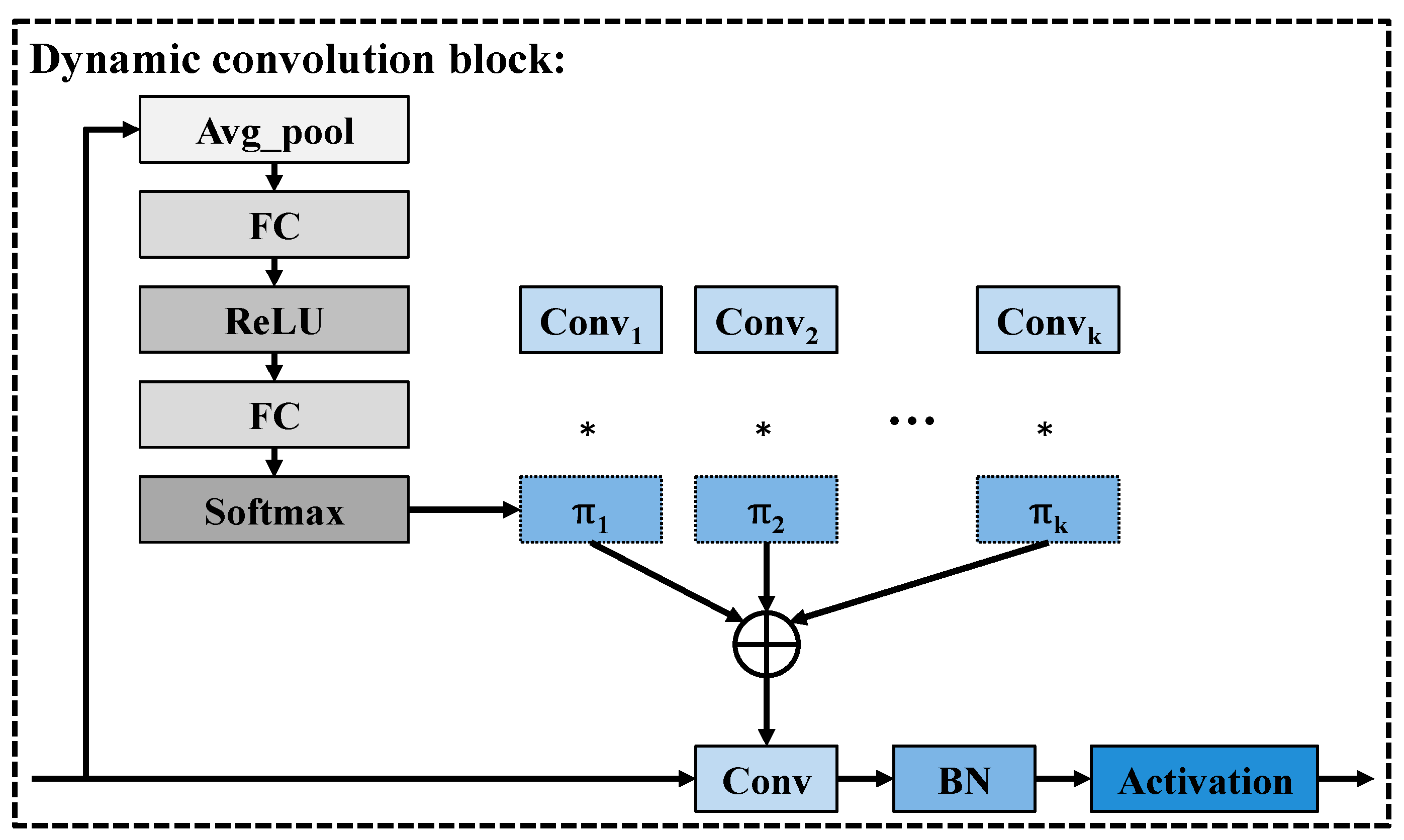
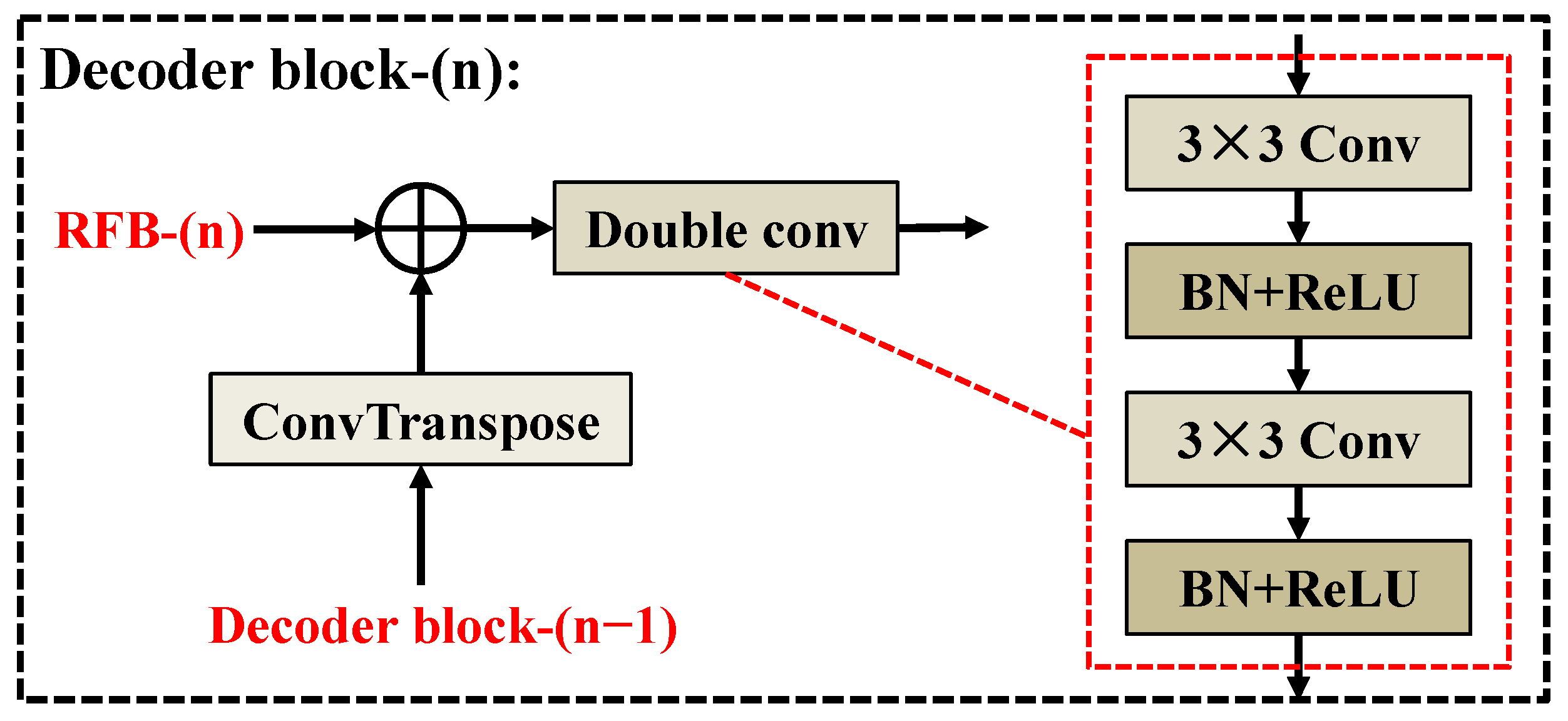
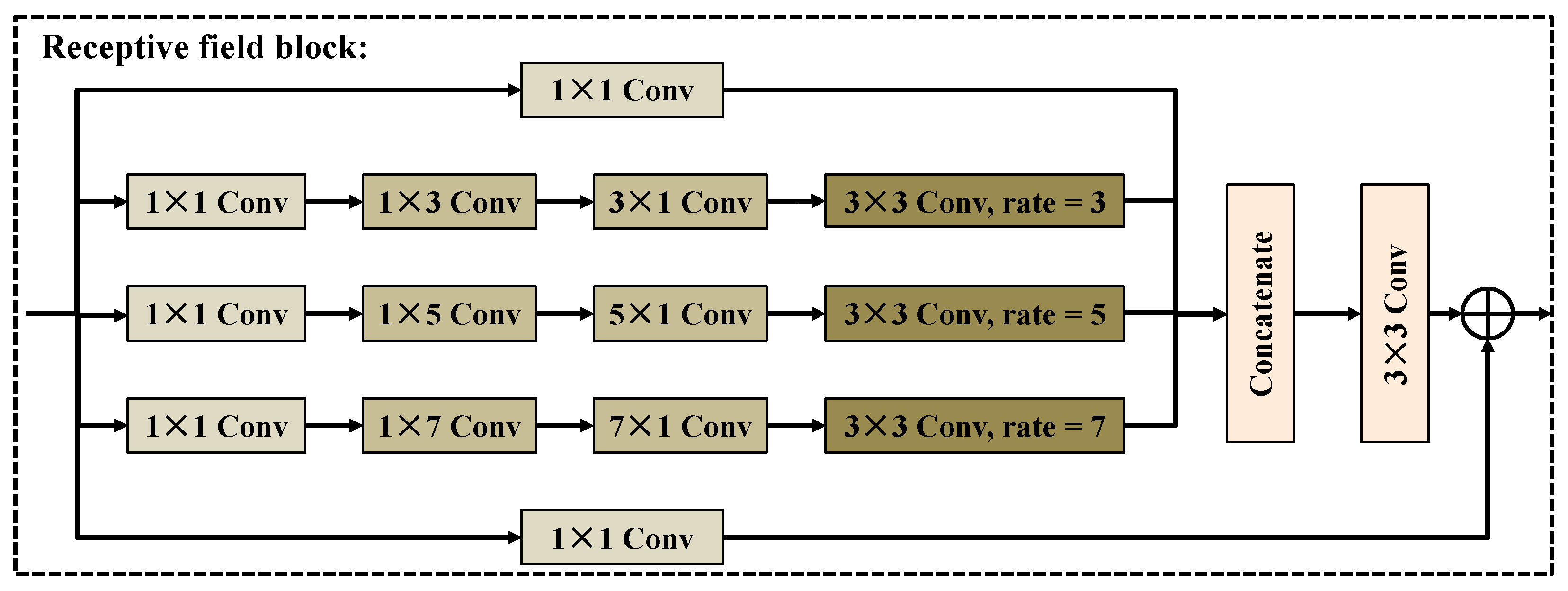



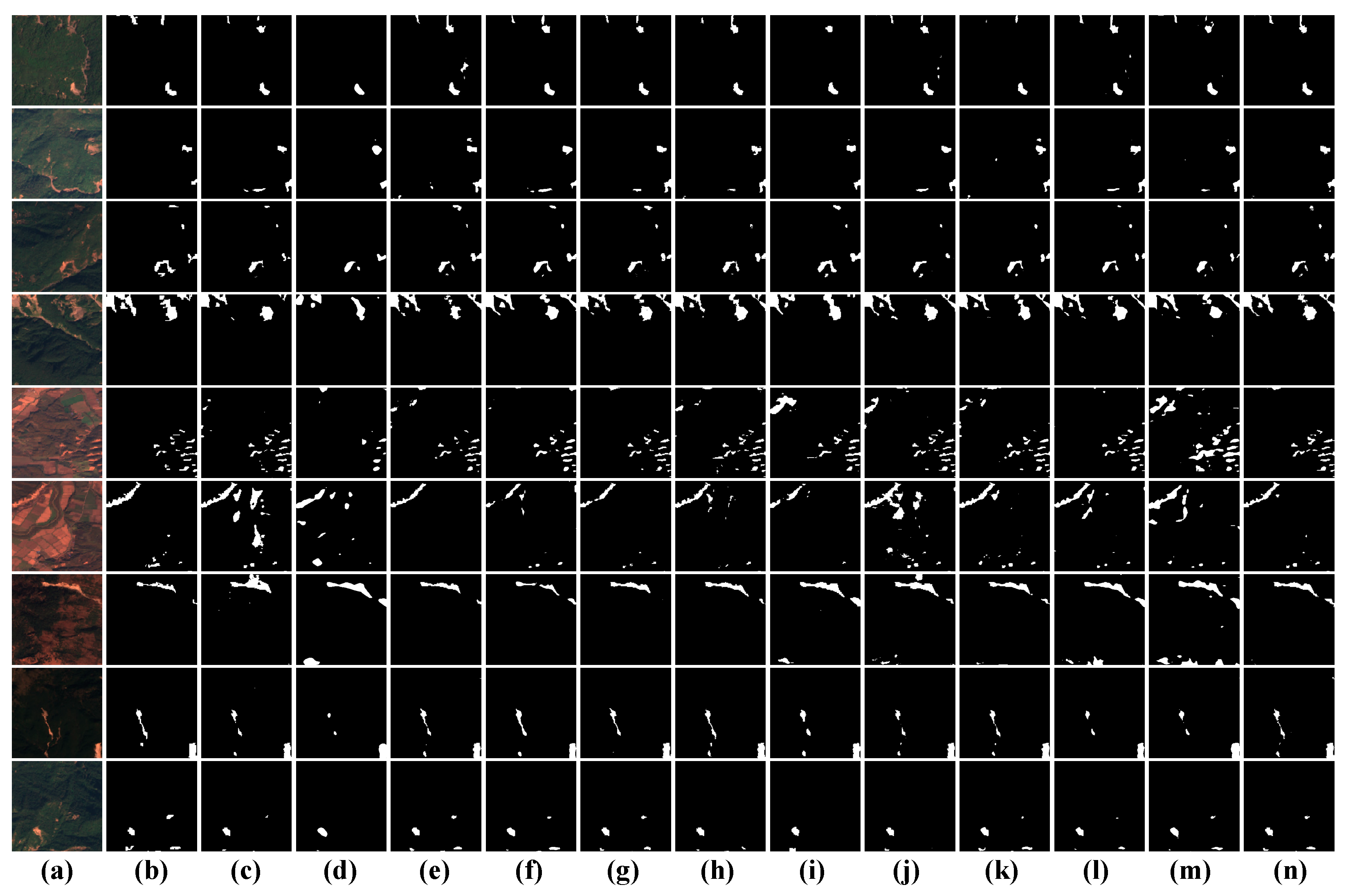

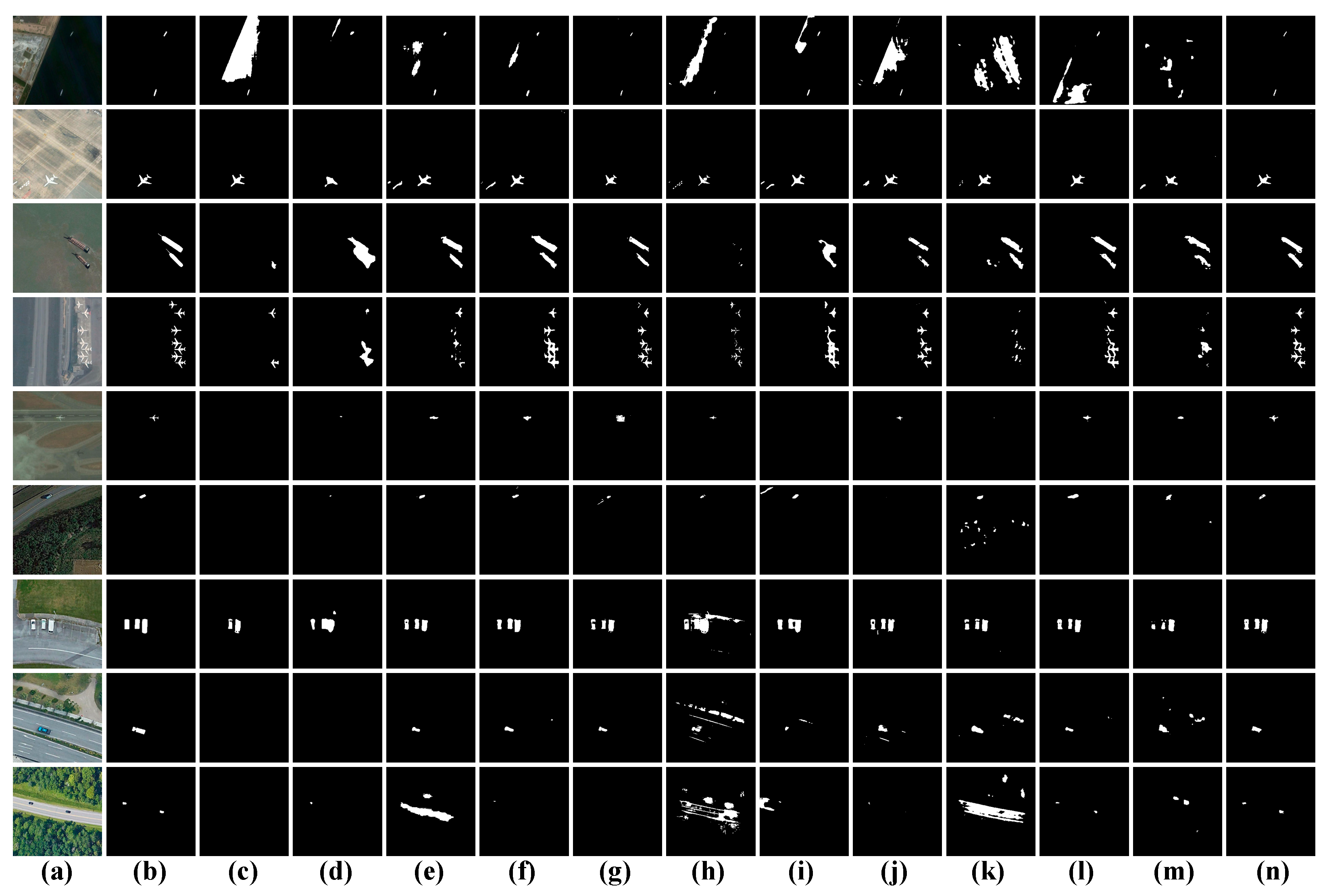
| Method | Dice | Mcc | Jaccard |
|---|---|---|---|
| U-Net [30] | 0.6731 | 0.6592 | 0.5096 |
| Baseline | 0.7091 | 0.6969 | 0.5503 |
| Baseline + RFB | 0.7194 | 0.7080 | 0.5626 |
| Baseline + MDCB | 0.7180 | 0.7081 | 0.5616 |
| Baseline + RFB + MDCB (MCFI-Net) | 0.7254 | 0.7138 | 0.5699 |
| Method | Dice | Mcc | Jaccard |
|---|---|---|---|
| MCFI-Net with ASPP | 0.7058 | 0.6946 | 0.5458 |
| MCFI-Net with Inception | 0.7061 | 0.6948 | 0.5475 |
| MCFI-Net without RFB | 0.6980 | 0.6881 | 0.5416 |
| MCFI-Net with RFB | 0.7254 | 0.7138 | 0.5699 |
| The First Branch | The Second Branch | Dice | Mcc | Jaccard |
|---|---|---|---|---|
| Dynamic convolutional | Standard convolutional | 0.7254 | 0.7138 | 0.5699 |
| Dynamic convolutional | Dynamic convolutional | 0.7098 | 0.6988 | 0.5518 |
| Standard convolutional | Standard convolutional | 0.7177 | 0.7053 | 0.5609 |
| / | Standard convolutional | 0.7126 | 0.6997 | 0.5545 |
| Dynamic convolutional | / | 0.7143 | 0.7021 | 0.5566 |
| Method | Dice | Mcc | Jaccard |
|---|---|---|---|
| U-Net [30] | 0.6731 | 0.6592 | 0.5096 |
| SeaNet [41] | 0.6310 | 0.6172 | 0.4648 |
| HST-UNet [42] | 0.6884 | 0.6757 | 0.5257 |
| MsanlfNet [43] | 0.6864 | 0.6735 | 0.5244 |
| IMFF-Net [44] | 0.7126 | 0.7012 | 0.5548 |
| SwinT [45] | 0.7016 | 0.6909 | 0.5422 |
| DECENet [46] | 0.6616 | 0.6484 | 0.4971 |
| BRRNet [47] | 0.7134 | 0.7010 | 0.5554 |
| EGENet [48] | 0.6694 | 0.6610 | 0.5094 |
| UNetFormer [49] | 0.6646 | 0.6527 | 0.5044 |
| DCSwin [50] | 0.6252 | 0.6118 | 0.4613 |
| MCFI-Net | 0.7254 | 0.7138 | 0.5699 |
| Method | Dice | Mcc | Jaccard |
|---|---|---|---|
| U-Net [30] | 0.7599 | 0.7336 | 0.6130 |
| SeaNet [41] | 0.7962 | 0.7741 | 0.6616 |
| HST-UNet [42] | 0.7855 | 0.7620 | 0.6476 |
| MsanlfNet [43] | 0.8019 | 0.7796 | 0.6693 |
| IMFF-Net [44] | 0.8073 | 0.7858 | 0.6770 |
| SwinT [45] | 0.7896 | 0.7666 | 0.6525 |
| DECENet [46] | 0.8132 | 0.7920 | 0.6853 |
| BRRNet [47] | 0.7922 | 0.7691 | 0.6561 |
| EGENet [48] | 0.7755 | 0.7520 | 0.6348 |
| UNetFormer [49] | 0.7996 | 0.7789 | 0.6672 |
| DCSwin [50] | 0.7577 | 0.7330 | 0.6114 |
| MCFI-Net | 0.8201 | 0.8004 | 0.6951 |
| Method | Dice | Mcc | Jaccard |
|---|---|---|---|
| U-Net [30] | 0.6433 | 0.6536 | 0.4813 |
| SeaNet [41] | 0.7067 | 0.7036 | 0.5588 |
| HST-UNet [42] | 0.7166 | 0.7109 | 0.5766 |
| MsanlfNet [43] | 0.7622 | 0.7572 | 0.6293 |
| IMFF-Net [44] | 0.7106 | 0.7026 | 0.5712 |
| SwinT [45] | 0.5773 | 0.5617 | 0.4155 |
| DECENet [46] | 0.7630 | 0.7589 | 0.6326 |
| BRRNet [47] | 0.7083 | 0.6979 | 0.5637 |
| EGENet [48] | 0.5896 | 0.5846 | 0.4375 |
| UNetFormer [49] | 0.7549 | 0.7525 | 0.6290 |
| DCSwin [50] | 0.6775 | 0.6703 | 0.5278 |
| MCFI-Net | 0.7770 | 0.7732 | 0.6571 |
| Method | GFLOPs | Params(M) | FPS |
|---|---|---|---|
| U-Net [30] | 3.49 | 1.95 | 227.32 |
| SeaNet [41] | 1.43 | 2.75 | 73.96 |
| HST-UNet [42] | 10.96 | 28.61 | 22.02 |
| MsanlfNet [43] | 6.95 | 32.24 | 28.09 |
| IMFF-Net [44] | 71.96 | 34.68 | 133.44 |
| SwinT [45] | 7.38 | 2.78 | 39.86 |
| DECENet [46] | 3.17 | 1.16 | 44.58 |
| BRRNet [47] | 58.79 | 14.93 | 150.62 |
| EGENet [48] | 15.53 | 2.98 | 80.42 |
| UNetFormer [49] | 2.93 | 11.68 | 104.20 |
| DCSwin [50] | 34.46 | 118.87 | 27.20 |
| MCFI-Net | 48.36 | 19.37 | 60.42 |
| Method | Dice | Mcc | Jaccard |
|---|---|---|---|
| Adam | 0.7254 | 0.7138 | 0.5699 |
| Nadam | 0.6989 | 0.6859 | 0.5391 |
| RMSprop | 0.6947 | 0.6824 | 0.5339 |
| Rprop | 0.6885 | 0.6764 | 0.5265 |
| SGD | 0.6796 | 0.6670 | 0.5165 |
| Method | Dice | Mcc | Jaccard |
|---|---|---|---|
| Dice | 0.7254 | 0.7138 | 0.5699 |
| FocalTversky | 0.5444 | 0.5786 | 0.3757 |
| IoU | 0.5415 | 0.5753 | 0.3726 |
| Tversky | 0.5327 | 0.5684 | 0.3644 |
Disclaimer/Publisher’s Note: The statements, opinions and data contained in all publications are solely those of the individual author(s) and contributor(s) and not of MDPI and/or the editor(s). MDPI and/or the editor(s) disclaim responsibility for any injury to people or property resulting from any ideas, methods, instructions or products referred to in the content. |
© 2025 by the authors. Licensee MDPI, Basel, Switzerland. This article is an open access article distributed under the terms and conditions of the Creative Commons Attribution (CC BY) license (https://creativecommons.org/licenses/by/4.0/).
Share and Cite
Liao, J.; Ye, L. MCFI-Net: Multi-Scale Cross-Layer Feature Interaction Network for Landslide Segmentation in Remote Sensing Imagery. Electronics 2025, 14, 4190. https://doi.org/10.3390/electronics14214190
Liao J, Ye L. MCFI-Net: Multi-Scale Cross-Layer Feature Interaction Network for Landslide Segmentation in Remote Sensing Imagery. Electronics. 2025; 14(21):4190. https://doi.org/10.3390/electronics14214190
Chicago/Turabian StyleLiao, Jianping, and Lihua Ye. 2025. "MCFI-Net: Multi-Scale Cross-Layer Feature Interaction Network for Landslide Segmentation in Remote Sensing Imagery" Electronics 14, no. 21: 4190. https://doi.org/10.3390/electronics14214190
APA StyleLiao, J., & Ye, L. (2025). MCFI-Net: Multi-Scale Cross-Layer Feature Interaction Network for Landslide Segmentation in Remote Sensing Imagery. Electronics, 14(21), 4190. https://doi.org/10.3390/electronics14214190






